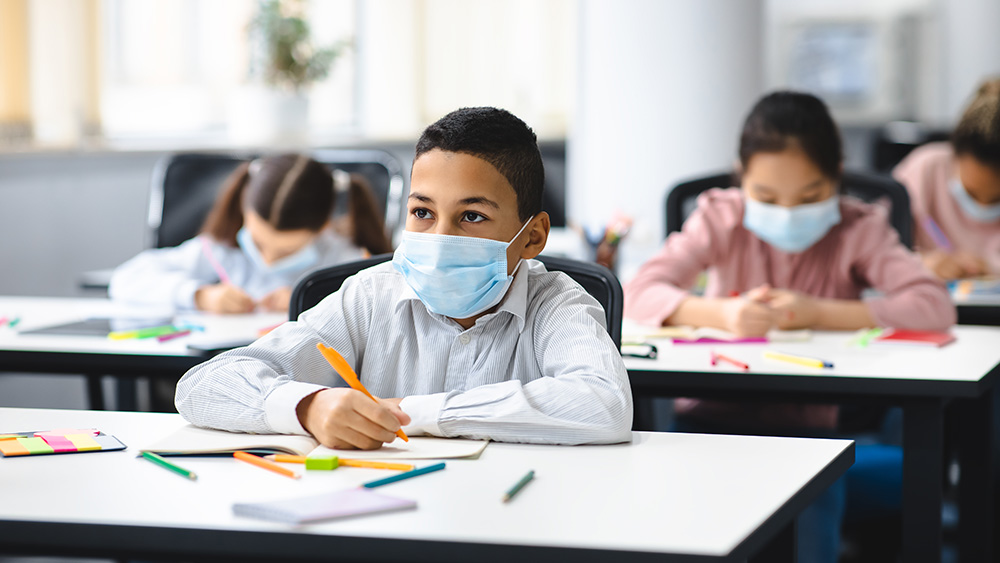
The test-to-stay strategy keeps kids who have been exposed to COVID-19 in school unless they test positive or develop symptoms, resulting in fewer missed days of school.

The test-to-stay strategy keeps kids who have been exposed to COVID-19 in school unless they test positive or develop symptoms, resulting in fewer missed days of school.
What you need to know
Most schools that were fully remote in 2020 have returned to in-person learning. To reduce the risk of COVID-19 spreading in school, some districts require mask-wearing indoors, while others allow mask-wearing as an option. Guidance on when students and staff should take COVID-19 tests and when they should stay home from school, varies widely.
During the 2021-2022 school year, many districts asked students and staff to attend remotely if they had close contact with someone with COVID-19, following Centers for Disease Control and Prevention guidance at the time. However, this strategy can disrupt students’ learning and social support. School districts are looking for policies that balance keeping kids in classrooms with preventing the spread of COVID-19.
Researchers at Duke University are studying a strategy called “test to stay,” in which someone who is exposed to COVID-19 can continue to go to school in person as long as they get negative results on a series of rapid tests. The researchers have found that the strategy dramatically reduces the number of missed days of school while keeping the risk of in-school spread low.
This research is supported by the Rapid Acceleration of Diagnostics (RADx®) Underserved Populations (RADx-UP) initiative, the National Center for Advancing Translational Sciences, and the Eunice Kennedy Shriver National Institute of Child Health and Human Development (NICHD).
What did the researchers do?
The researchers enrolled 2,463 people from 9 school districts in North Carolina to participate in the test-to-stay study. Unlike a previous study by the same team that focused on schools that required students and staff to wear masks, the new study took place in schools where mask-wearing was optional.
Approximately two-thirds (1,675) of the participants had close contact with someone with COVID-19 between mid-November 2021 and late January 2022 and completed a series of rapid tests: first on the day they learned of the exposure, then the third day after that, and finally the fifth day. They were also monitored for COVID-19 symptoms for up to 14 days.
As long as a student tested negative, they could continue going to school for in-person learning. They could also join athletic activities if they wore a mask. Participants needed to stay home only if they tested positive for COVID-19 or developed symptoms.
What did the researchers learn?
During the study, participants collectively missed 934 in-school days because of COVID-19 exposures. However, the researchers estimated that the same participants would have missed 8,206 days of school if they had to quarantine after exposure.
The researchers also kept track of in-school COVID-19 exposures linked to participants who tested positive. About 200 students were exposed to COVID-19 in school by someone who was following the test-to-stay strategy, and about 10% of those exposed also got COVID-19. Based on their results, the researchers estimate that there was about one school-acquired case of COVID-19 for every 21 test-to-stay participants in the building.
Why is this research important?
This research helps school districts assess the risk levels of different COVID-19 policies. Using a test-to-stay approach can reduce the number of school days that students miss. The strategy was found to have about a 10% risk of COVID-19 transmission in schools where mask-wearing is optional, and less than 5% risk of transmission in schools where mask-wearing is required.
Where can I go to learn more?
-
NIH shares current information about COVID-19 testing.
How Kids Can Go Back to School Safely
-
Many researchers are studying ways to keep students safe from COVID-19 while attending school.
How Does Wearing Masks Affect Children?
-
NICHD supports research to understand the effect of mask-wearing on child development.
Sources
- Campbell, M. M., Benjamin, D. K., Mann, T. K., Fist, A., Blakemore, A., Diaz, K. S., Kim, H., Edwards, L. J., Rak, Z., Brookhart, M. A., Moore, Z., Tilson, E. C., Kalu, I., Boutzoukas, A. E., Moorthy, G. S., Uthappa, D., Scott, Z., Weber, D. J., Shane, A. L., Kristina A. Bryant, K. A., & Zimmerman, K. O.; on behalf of the ABC Science Collaborative. (2022). Test-to-stay after SARS-CoV-2 exposure: A mitigation strategy for optionally masked K–12 schools. Pediatrics, 150(5), e2022058200. https://doi.org/10.1542/peds.2022-058200
- Campbell, M. M., Benjamin, D. K., Mann, T., Fist, A., Kim, H., Edwards, L., Rak, Z., Brookhart, M. A., Anstrom, K., Moore, Z., Tilson, E. C., Kalu, I. C., Boutzoukas, A. E., Moorthy, G. S., Uthappa, D., Scott, Z., Weber, D. J., Shane, A. L., Bryant, K. A., & Zimmerman, K. O.; ABC Science Collaborative. (2022). Test-to-stay after exposure to SARS-CoV-2 in K–12 schools. Pediatrics, 149(5), e2021056045. https://doi.org/10.1542/peds.2021-056045

News and Stories
Read stories about the efforts underway to prevent, detect, and treat COVID-19 and its effects on our health.
 An official website of the United States government
An official website of the United States government

